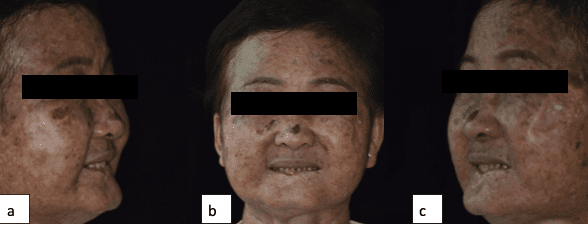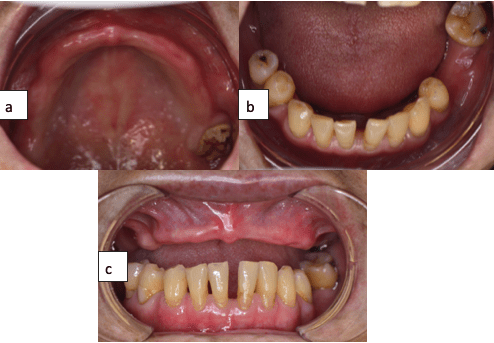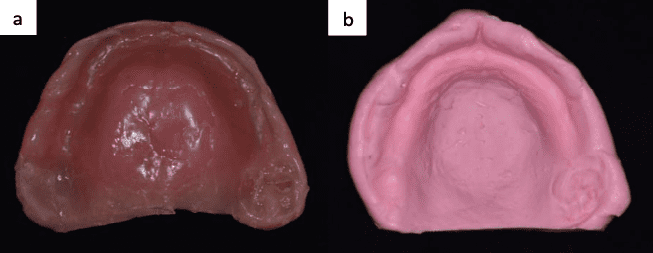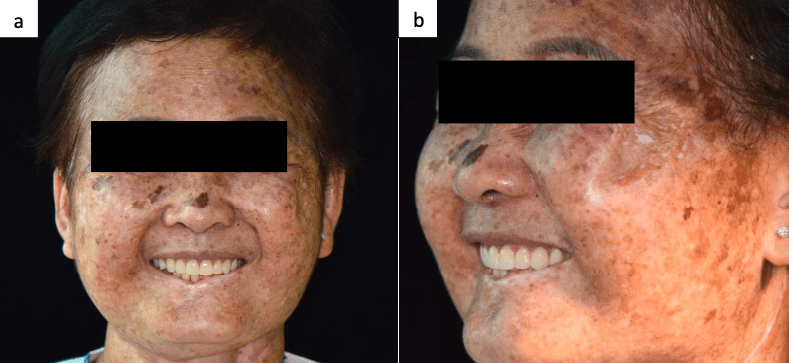By Dr. Chung Yee Shien and Dr. Selva Malar Munusamy
Introduction
Microstomia is a condition characterized by reduced oral aperture with diagnosis determined by its effects on both function and aesthetic, rather than specific size criteria (Garnett et al., 2008). It may be congenital, developmental, or acquired, which can arise from a variety of causes, including burns, facial trauma, connective tissue disorders, and surgical interventions following oral and lip cancers (Gruniebaum et al., 2010). Microstomia is often associated with mandibular hypomobility (trismus), which can result from temporomandibular joint disorders, direct trauma, surgical procedures, or the effects of localized radiation therapy for head and neck cancer treatment (Dhanrajani & Jonaidel, 2002).
The normal range for mouth opening is generally between 40 and 60 mm, although some studies set the lower limit at 35 mm (Rieder, 1978; Mezitis et al., 1984). In cases of microstomia and mandibular hypomobility, this normal range is significantly reduced, resulting in limited intraoral access that affects oral hygiene, chewing, and speech. These functional and aesthetic difficulties, including reduced lip mobility, thickening and loss of elasticity in the oral tissues, can affect self-esteem, social interactions and other daily activities (Ki & Park, 2024).
In this case, the patient presented with both microstomia and mandibular hypomobility following treatment for lip squamous cell carcinoma. These factors make prosthetic rehabilitation for microstomia patients challenging at every stage, from taking initial impressions to fabricating the prosthesis, thus requiring comprehensive evaluation and management. The process of taking accurate impression is often the first major challenge. To overcome this, modifying standard impression techniques is often necessary, and using the existing prosthesis as an impression tray can simplify the process (Heasman et al., 1994; Garnett et al., 2008). Therefore, this clinical case report demonstrated the use of patient’s existing denture for impression taking to facilitate subsequent steps in denture fabrication, aimed at restoring masticatory function, enhancing aesthetic appearance, improving oral comfort, and ultimately increasing the patient’s overall satisfaction.
Case Description
A 54-year-old Chinese lady was referred from the Oral and Maxillofacial Surgery (OMFS) Department of Faculty of Dentistry, Universiti Malaya to the Prosthodontic Postgraduate Clinic for management of her ill-fitting upper denture. She presented with concerns about her worn and loose upper denture, which was affecting her eating and appearance. Patient had been using current denture since 2014, nearly a decade ago.
Patient had a medical history of Squamous Cell Carcinoma (SCC) of the lower lip (T2N0M0), with surgical excision performed in 2013, followed by adjunct radiotherapy. In 2022, the patient underwent excision of a recurrent SCC (T1N0M0, poorly differentiated) and was on annual follow-up under the Oral and Maxillofacial Surgery (OMFS) department at Faculty of Dentistry, Universiti Malaya. Moreover, patient had a history of Basal Cell Carcinoma on the left ala of the nose, for which an excisional biopsy was performed in 2021. Patient also had lentigo on the arms and chin. Other medical conditions include Type II diabetes mellitus, managed with Metformin 500mg and Gliclazide 80mg; dyslipidaemia, managed with Atorvastatin 20mg; and asthma, managed with a Salbutamol inhaler.
Upon clinical examination, several key observations were noted. Her face appeared symmetrical with incompetent lips at rest and distinct small spots or patches were seen on the skin, ranging from light brown to dark brown in colour. She had clicking sounds in both the left and right temporomandibular joints but asymptomatic. There was reduced mouth opening with limited movement of mandible. The submandibular lymph nodes were not palpable. Facial profile was classified as Class III (Figure 1). She presented with reduced oral aperture and uneven lip thickness during both closure and smiling. Lower lip appeared thinner and irregular with scarring (Figure 2a). When smiling, the lower teeth display was prominent (Figure 2b). The interarch vertical distance was reduced to 19 mm (Figure 2c) while the intercommissural width measured at 37mm (Figure 2d).


Intraoral examination showed moderate resorption of the maxillary arch residual ridge, with both width and height reduced. The frenal attachment was low, and the palatal vault was average. Remaining tooth 28 had some enamel changes with arrested caries (Figure 3a). Generalized gingival recession and abrasion cavities were noted (Figure 3b), along with old restorations showing defective margins and discoloration (Figure 3c). The old maxillary overdenture was noted with severe worn and shortened teeth, uneven peripheral extensions, cracks, and reline materials applied by a previous dentist (Figure 4).


Based on these findings, the diagnosis included: (i) microstomia, (ii) mandibular hypomobility, and (iii) maxillary and mandibular partially dentate arches. The primary treatment goals were to restore masticatory function and improve aesthetics. Treatment options were discussed with the patient, who opted for conventional complete removable acrylic overdenture for the maxillary arch opposed mandibular shortened dental arch.
In the pre-prosthetic phase, professional mechanical plaque removal was carried out, followed by polishing with prophylaxis paste (Prophy Paste, Kemdent, UK). Composite restorations (3M ESPE Filtek Z250 XT Universal, USA) were done on teeth 45, 44, 42, 41, and 34 under rubber dam isolation. Overhanging restorations on teeth 31 and 32 were removed using a fine diamond bur and polished with a composite polishing kit. As part of the initial caries management for tooth 28, a 5% sodium fluoride (NaF) topical varnish (Duraphat®, Colgate Palmolive) was applied as a preventive treatment.
Preliminary impression of the maxillary arch was made using alginate (Kromopan, Lascod, Italy) with existing denture (Figure 5). For the mandibular arch, an impression was made using the small size stock tray. The impressions were disinfected and then poured with type III green stone (Dentona AG, Germany) to create study models (Figure 6). Final impression was taken using medium-body, regular-set polyvinylsiloxane (PVS) impression material (Aquasil Ultra+, Dentsply Sirona, USA) and master cast was created (Figure 7).



The maxillomandibular relationship was recorded in centric relation using occlusal wax bite rims. Master casts with registered bite block were mounted on the articulator (KaVo PROTARevo 5, USA) and teeth set-up was done (Figure 8). Once the teeth arrangement was finalized, the waxed trial dentures were placed in the patient’s mouth for a clinical try-in (Figure 9).


The final denture was fabricated and processed using heat-cured polymethyl methacrylate (PMMA) denture base resin (Huge Dental, China). At issue stage, the extensions of the dentures were checked to ensure a proper fit and adequate adaptation. Retention and stability were assessed. Occlusion was then adjusted for both centric and eccentric movements using 65-microns horseshoe articulating paper (Double Check, Swedent, Sweden) to achieve a stable occlusion (Figure 10). Facial aesthetics were assessed during smiling (Figure 11), focusing on how the dentures impacted the appearance of the lips, facial contours, and overall smile dynamics (Figure 12). Additionally, a speech assessment was performed to evaluate the articulation of specific sounds and ensure proper pronunciation. Oral and denture hygiene instructions were given to patient.
Patient was reviewed one week and one month after denture delivery. Overall, patient reported good tolerance and expressed satisfaction with the current denture. The aesthetic appearance was significantly improved, contributing to a more natural and pleasing smile. There was noticeable improvement in comfort, with better retention and stability, resulting in enhanced chewing efficiency.
<< Back to Contents Menu
EDITOR’S PAGE | ADVISORY BOARD | NEWS | PRODUCTS | COVER FEATURE | CLINICAL | EXHIBITIONS & CONFERENCES



Discussion
This case involved a challenging clinical scenario, with patient presenting microstomia and mandibular hypomobility following treatment for squamous cell carcinoma. This patient had severe restricted vertical mouth opening of 19mm. This significant limitation in oral access posed considerable challenges for prosthetic rehabilitation. In these circumstances, the patient’s existing maxillary denture was utilized to capture the primary impression by rotational path of insertion, facilitating the subsequent steps in prosthetic treatment process (Heasman et al., 1994; Garnett et al., 2008).
Maxillary overdenture supported by the patient’s remaining natural teeth was selected as the treatment approach in the upper arch (Leong et al., 2024). This approach was chosen because the remaining tooth 28 was in good condition, allowing for its preservation and avoiding the need for extraction, which could have increased the risk of osteoradionecrosis, as patient had underwent head and neck radiotherapy. Maximal denture extension with proper posterior palatal seal was achieved, which was critical for the stability and retention of the prosthesis (Ettinger & Scandrett, 1980).
In the lower arch, shortened dental arch concept was selected as the treatment option. Given that the patient still had at least four occlusal units left and sufficient adaptive capacity with 10 occluding pair units between denture and natural dentition, the treatment plan focused on restoring adequate oral function with the current dentition (Kayser, 1981; Witter et al., 1999; Powell, 2016). In addition, mandibular shortened dental arch was deemed tolerable in this patient since patient showed reduced occlusal forces and functional movements due to mandibular hypomobility. This approach avoided overtreatment while addressing the patient’s functional and comfort needs. However, to minimize potential risks associated to this approach such as instability, premature wear, and mechanical failure, equilibration of opposing occlusal plane was prioritized (Andrei and Radu, 2010). By achieving a balanced distribution of occlusal forces, excessive leverage on the denture was minimized, thereby enhancing its long-term stability and functionality (Garnett et al., 2008).
Biometric guides were used for teeth arrangement to restore the natural position of the lips and cheeks. Despite the patient’s upper lip appearing more prominent due to the unsupported thin lower lip caused by the defect, the lip contour was restored satisfactorily and the patient was able to have competent lips at rest. This was achieved by appropriately adjusting the teeth inclination to obtain a nasolabial angle near to 90 degrees, which helped create a more balanced and natural appearance. For a pleasing smile, the upper anterior teeth were positioned so that their incisal edges followed the curve of the smiling lower lip. This approach minimized the visibility of patient’s lip defects (Watt, 1978).
Following the dentogenic concept, the choice of teeth was influenced by the patient’s age, gender, and personality to achieve a natural look. For this patient, small, rounded teeth were selected to complement a more feminine appearance (Frush & Fisher, 1959). This approach helped avoid the “denture look” commonly seen with overly symmetrical or unnatural teeth arrangements, a problem that had been evident with the patient’s previous ill-fitting denture.
Conclusion
The use of the patient’s existing denture as an impression tray for taking impression in case of microstomia and mandibular hypomobility is an effective and practical approach. This method simplifies the subsequent steps in denture fabrication. Treatment approach of maxillary overdenture opposing a shortened dental arch with incorporation of biometric guides for tooth arrangement ensured optimal function and aesthetics. The approach addressed both physical and psychosocial challenges associated with microstomia and mandibular hypomobility, resulting in a significant improvement in the patient’s overall satisfaction and Oral Health- Related Quality of Life (OHRQoL) following prosthetic rehabilitation.
References
- Andrei, O., & Radu, I. (2010). Diagnosing and treating the functional problems of the patient with upper single denture: Case report. Therapeutics, Pharmacology and Clinical Toxicology, 16(2), 145-161.
- Dhanrajani, P. J., & Jonaidel, O. (2002). Trismus: aetiology, differential diagnosis and treatment. Dental Update, 29(2), 88–94. https://doi.org/10.12968/denu.2002.29.2.88
- Ettinger, R. L., & Scandrett, F. R. (1980). The posterior palatal seal: A review. Australian Dental Journal, 25(4), 197-200.
- Frush, J. P., & Fisher, R. D. (1959). Dentogenics: Its practical application. Journal of Prosthetic Dentistry, 9(6), 914–921.
- Garnett, M. J., Nohl, F. S., & Barclay, S. C. (2008). Management of patients with reduced oral aperture and mandibular hypomobility (trismus) and implications for operative dentistry. British Dental Journal, 204(3), 125–131. https://doi.org/10.1038/bdj.2008.47
- Grunebaum, L. D., Smith, J. E., & Hoosien, G. E. (2010). Lip and perioral trauma. Facial Plastic Surgery: FPS, 26(6), 433–444. https://doi.org/10.1055/s-0030-1267717
- Heasman, P. A., Thomason, J. M., & Robinson, J. G. (1994). The provision of prostheses for patients with severe limitation in opening of the mouth. British Dental Journal, 176, 171-174.
- Käyser A. F. (1981). Shortened dental arches and oral function. Journal of oral rehabilitation, 8(5), 457–462. https://doi.org/10.1111/j.1365-2842.1981.tb00519.x
- Ki, S. H., & Park, T. J. (2024). Prevention and treatment of microstomia. Archives of Craniofacial Surgery, 25(3), 105–115. https://doi.org/10.7181/acfs.2024.00276
- Leong, P. M., & Zhang, P. (2024). The role of overdentures in patients with edentulous arches. Journal of Prosthodontics, 33(1), 18–24. https://doi.org/10.1111/jopr.13135
- Mezitis, M., Rallis, G., & Zacharides, N. (1984). The normal range of mouth opening. Journal of Oral and Maxillofacial Surgery, 47, 1028–1029.
- Powell, L. (2016). Case study: Management of a loose upper denture opposed by a shortened dental arch. Dental Update, 43(10), 961–963. https://doi.org/10.12968/denu.2016.43.10.961
- Rieder, C. E. (1978). Maximum mandibular opening in patients with and without a history of TMJ dysfunction. Journal of Prosthetic Dentistry, 39, 441–446.
- Watt, D. M. (1978). Tooth positions on complete dentures. Journal of Dentistry, 6(2), 147–160. https://doi.org/10.1016/0300-5712(78)90211-7
- Witter, D. J., van Palenstein Helderman, W. H., Creugers, N. H., & Käyser, A. F. (1999). The shortened dental arch concept and its implications for oral health care. Community Dentistry and Oral Epidemiology, 27(4), 249–258. https://doi.org/10.1111/j.1600- 0528.1998.tb02018.x

Dr. Chung Yee Shien graduated with a Bachelor of Dental Surgery (BDS), Universiti Malaya in 2014 and has been actively serving under the Ministry of Health in Kuching, Sarawak, since then. Over the course of her career, she spent three years working at the Oral Maxillofacial Surgery Department, Dental Specialist Clinic, Sarawak General Hospital, where she gained experience in managing complex dental and surgical cases. Following this, she served as an Attachment Officer at the Restorative Dental Specialist Unit, Petra Jaya Dental Clinic, Kuching, Sarawak, where she developed her skills and knowledge in advanced restorative treatments, with a focus on both functional and aesthetic rehabilitation. She earned the Membership of the Faculty of Dental Surgery (MFDS) from the Royal College of Surgeons of Edinburgh in 2017. In 2023, she completed her Master of Oral Science in Prosthodontics at Universiti Malaya. Currently, she is pursuing a Doctor in Prosthodontics at Universiti Malaya, where she is engaged in advanced research and clinical practice, aiming to contribute to the field of prosthodontics.

Dr. Selva Malar Munusamy is a senior lecturer and Consultant in Prosthodontics at the Department of Restorative Dentistry, Faculty of Dentistry, Universiti Malaya, Kuala Lumpur, Malaysia. She received her Bachelor in Dental Surgery from Universiti Malaya in 2007 and Clinical Masters in Fixed and Removable Prosthodontics from The University of Manchester, United Kingdom in 2015.She is an active member of the Faculty of Dental Surgery, Royal College of Surgeons of Edinburgh, United Kingdom, member of the International Association for Dental Research (IADR) Malaysian Section and member of the Malaysian Dental Material Society. She currently holds the post as Deputy Head for the Doctor in Prosthodontics Postgraduate programme at the Faculty of Dentistry, Universiti Malaya, Kuala Lumpur, Malaysia. Her fields of research include dental materials in particular CAD/CAM materials, prosthodontics and special needs dentistry. She holds a national record in the The Malaysia Book of Records, 2023 for the First Oral Health Braille Book in Malaysia. Her other achievements include invited speaker at the 7th International Conference on Materials Science and Nanotechnology, Innovinc International, Vienna 2024, 2nd place winner at the 7th Malaysia International Dental Show 2024, speaker for Haleon Wellness Webinar 2023 and gold award recipient in the International Invention and Innovation in Dentistry Exhibition (IIIDENTEX) 2023 and 2022.
The information and viewpoints presented in the above news piece or article do not necessarily reflect the official stance or policy of Dental Resource Asia or the DRA Journal. While we strive to ensure the accuracy of our content, Dental Resource Asia (DRA) or DRA Journal cannot guarantee the constant correctness, comprehensiveness, or timeliness of all the information contained within this website or journal.
Please be aware that all product details, product specifications, and data on this website or journal may be modified without prior notice in order to enhance reliability, functionality, design, or for other reasons.
The content contributed by our bloggers or authors represents their personal opinions and is not intended to defame or discredit any religion, ethnic group, club, organisation, company, individual, or any entity or individual.
